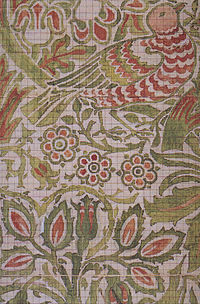
Photo from wikipedia
With the acceleration of economic development, people put forward higher requirements for clothing style. In this context, the application of traditional patterns has good artistic effects, can show a unique… Click to show full abstract
With the acceleration of economic development, people put forward higher requirements for clothing style. In this context, the application of traditional patterns has good artistic effects, can show a unique style, and can also express the artistic beauty of clothing through deformation, color distribution, and other forms, and occupies a relatively large position in the design process of dyeing and weaving art. Aiming at the problem of inaccurate extraction of image information from known visual scenes in the original art-aided design, resulting in unclear output images, this paper proposes a computer-aided design algorithm for dyeing and weaving graphics in the field of public art by color segmentation of the known visual scene images according to the set threshold, morphological processing of the segmented images, reducing noise and fractures affecting the acquired connected areas, and formulating extraction rules to screen candidate areas. Furthermore, dense sampling form is used to extract more scale invariant feature transform (SIFT) target features in the candidate area, match the feature points, integrate the coordinate system of known image information into a unified coordinate system, output the design image, and complete the auxiliary design of dyeing and weaving graphics. The results of simulation experiments show that the computer-aided design algorithm of dyeing and weaving graphics in the public art field is more accurate than the original method in extracting information from known images, which helps to solve the problem of clear output dyeing and weaving images, and improves the quality of dyeing and weaving images.
Journal Title: Computational Intelligence and Neuroscience
Year Published: 2022
Link to full text (if available)
Share on Social Media: Sign Up to like & get
recommendations!